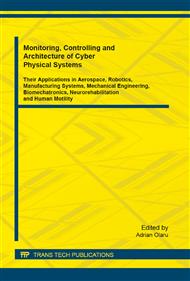[1]
Voitsekhovskii, B. V., Mitrofanov, V.V. and Topchiyan, M. E., Structure of the detonation front in gases, Izdatielstvo SO AN SSSR, Novosibirsk, (in Russian), (1963).
Google Scholar
[2]
J.A. Nicholls, H.R. Wilkinson, R.B. Morrison, Intermittent Detonation as a Thrust-Producing Mechanism, Jet Propulsion, AIAA, 27 (5), 1957, pp.534-541.
DOI: 10.2514/8.12851
Google Scholar
[3]
Kailashnath K, Recent Developments in the Research on Pulse Detonation Engine, AIAA Journal, Vol. 41, No. 2, 2003; 145-159.
Google Scholar
[4]
G. Ciccarelli and S. Dorofeev, Flame acceleration and transition to detonation in ducts, Progress in Energy Combustion Science, Vol. 34, pp.499-550, (2008).
DOI: 10.1016/j.pecs.2007.11.002
Google Scholar
[5]
A. A. Vasil'ev, V. I. Zvegintsev, and D. G. Nalivaichenko, Detonation Waves in a Reactive Supersonic Flow, Combustion, Explosion and Shock Waves, Vol. 42, No. 5, pp.568-581, (2006).
DOI: 10.1007/s10573-006-0089-4
Google Scholar
[6]
Pinku Debnath & K. M. Pandey, Performance Investigation on Single Phase Pulse Detonation Engine Using Computational Fluid Dynamics, Proceedings of the ASME 2013 International Mechanical Engineering Congress & Exposition, IMECE2013, November 15-21, 2013, SAN DIEGO, CA, USA, IMECE2013-66274.
DOI: 10.1115/imece2013-66274
Google Scholar
[7]
Oran E. S., Gamezo V. N., Origins of the Deflagration-to-Detonation Transition in Gas-Phase Combustion", Combustion and Flame, Vol. 148, Issues 1-2, 2007; 4-47.
DOI: 10.1016/j.combustflame.2006.07.010
Google Scholar
[8]
Navid Mehrjoo, Rocco Portaro, Hoi Dick Ng, A technique for promoting detonation transmission from a confined tube into larger area for pulse detonation engine applications, Propulsion and Power Research, 2014; 3(1); 9-14.
DOI: 10.1016/j.jppr.2014.01.003
Google Scholar
[9]
K. Kailasanath, Review of Propulsion Applications of Detonation Waves, AIAA Journal, Vol. 38, No. 9, September (2000).
Google Scholar
[10]
Wojciech Rudy, Rafal Porowski, Andrzej Teodorczyk, Propagation of hydrogen-air detonation in tube with obstacles, Journal of Power Technologies, 91 (3) 2011; 122-129.
Google Scholar
[11]
Damir Valiev, Vitaly Bychkov et. al. Flame acceleration in channels with obstacles in the deflagration-to-detonation transition, Combustion and Flame, 157 (5), 2010; 1012-1021.
DOI: 10.1016/j.combustflame.2009.12.021
Google Scholar
[12]
D. A. Kessler, V. N. Gamezo, E. S. Oran and R. K. Zipf, Simulation of Deflagration-to Detonation Transition in Premixed CH4-Air in Large-Scale Channels with Obstacles, 47th AIAA Aerospace Sciences Meeting Including The New Horizons Forum and Aerospace Exposition, 5-8 January 2009, Orlando, Florida.
DOI: 10.2514/6.2009-439
Google Scholar
[13]
Andre Vagner Gaathaug, Knut Vaagsaether, Dag Bjerketvedt, Experimental and numerical investigation of DDT in hydrogen Air behind a single obstacle, International Journal of Hydrogen Energy, Vol. 37, 2012; 17606-17615.
DOI: 10.1016/j.ijhydene.2012.03.168
Google Scholar
[14]
Vadim N. Gamezo, Takanobu Ogawa and Elaine S. Oran, Numerical Simulations of Flame Propagation and DDT in Obstructed Channels filled with hydrogen-air mixture, Proceeding of the Combustion Institute, Vol. 31, Issue 2, 2007, pp.2463-2471.
DOI: 10.1016/j.proci.2006.07.220
Google Scholar
[15]
Craig T. Johansen, Gaby Ciccarelli, Visualization of the unburned gas flow field ahead of an accelerating flame in an obstructed square channel, Combustion and Flame, Vol. 156, Issue 2, (2009) pp.405-416.
DOI: 10.1016/j.combustflame.2008.07.010
Google Scholar
[16]
C. Johansen & G. Ciccarelli, Numerical simulations of the flow field ahead of an accelerating flame in an obstacle, Combustion Theory and Modeling, Volume 14, Issue 2, 2010; 235-255.
DOI: 10.1080/13647830.2010.483020
Google Scholar
[17]
Moen IO, Donato M, Knystautas R, Lee J H., Flame acceleration due to turbulence produced by obstacles, Combustion and Flame, Vol. 39, Issue 1, 1980; 21-32.
DOI: 10.1016/0010-2180(80)90003-6
Google Scholar
[18]
G. Ciccarelli, C. Johansen and M. Parravani, The role of shock flame interactions on flame acceleration in an obstacle laded channel, Combustion and Flame, Vol. 157 Issue 11, November 2010; 2125-2136.
DOI: 10.1016/j.combustflame.2010.05.003
Google Scholar
[19]
Takanobu Ogawa, Vadim N et. al., Flame acceleration and transition to detonation in an array of square obstacles, Journal of Loss Prevention in the Process Industries, Vol. 26, Issue 2, 2013; 355-362.
DOI: 10.1016/j.jlp.2011.12.009
Google Scholar
[20]
Vadim N. Gamezo, Takanobu Ogawa, Elaine S. Oran, Flame acceleration and DDT in channels with obstacles: Effect of obstacle spacing, Combustion and Flame, Vol. 155, Issue 1-2, 2008; 302-315.
DOI: 10.1016/j.combustflame.2008.06.004
Google Scholar
[21]
P Debnath, K M Pandey, Deflagration to Detonation Transition Enhancement in Pulse Detonation Engine Using CFD, International Conference on Modeling, Optimization and Computing (ICMOC 2014) 10th -11th April, 2014, Noorul Islam University, India.
Google Scholar


